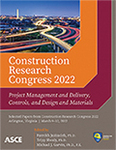Developing a Multivariate Time-Series Model to Forecast the Level of Competition in Transportation Projects
Publication: Construction Research Congress 2022
ABSTRACT
Forecasting the level of competition is critical for letting, investing, and pricing strategies for transportation owners and contractors. For instance, it helps owner organizations establish better letting strategies, such as scheduling projects for bid, balancing projects in a letting, and packaging projects into proposals. Moreover, for the contractors, it helps to establish investing and pricing strategies, such as the decision for participating in a bid and adjusting the mark-up (profit) level for the bid. Thus, this paper aims to identify the leading indicators of the level of competition for transportation projects and create multivariate time series models for forecasting the level of competition. The study uses the monthly level of competition of highway projects let in the state of Georgia between 2010 and 2018. Ten potential leading indicators of the level of competition, representing the local highway construction market, the construction market, the energy market, and macroeconomic market conditions, were used in this study. This study found the gross domestic product (GDP) of the Georgia construction industry and the number of hires as the leading indicators of the level of competition through the Granger causality test. Vector Error Correction (VEC) models were then developed for forecasting the level of competition with the identified leading indicators. The predictability of the developed VEC model for the level of competition represents a useful tool for making decisions in letting, investing, and pricing the transportation project.
Get full access to this article
View all available purchase options and get full access to this chapter.
REFERENCES
Al-Arjani, A. H. (2002). Type and size of project influences on number of bidders for maintenance and operation projects in Saudi Arabia. International Journal of Project Management, 20(4), 279–287.
Baek, M., and Ashuri, B. (2018). Statistical modeling of number of bidders in highway resurfacing and widening construction projects. In Construction Research Congress 2018 (pp. 670–679).
Baek, M., and Ashuri, B. (2019). Analysis of the variability of submitted unit price bids for asphalt line items in highway projects. Journal of Construction Engineering and Management, 145(4), 04019020.
Ballesteros-Pérez, P., Skitmore, M., Sanz-Ablanedo, E., and Verhoeven, P. (2019). Forecasting the Number and Distribution of New Bidders for an Upcoming Construction Auction. Journal of Construction Engineering and Management, 145(10), 04019056.
Breusch, T. S. (1978). Testing for autocorrelation in dynamic linear models. Australian Economic Papers, 17(31), 334–355.
Cao, Y., Ashuri, B., and Baek, M. (2018). Prediction of unit price bids of resurfacing highway projects through ensemble machine learning. Journal of Computing in Civil Engineering, 32(5), 04018043.
Cheng, G., and Wilmot, C. G. (2009). “Louisiana Highway Construction Cost Trend after Hurricanes Katrina and Rita.” Journal of Construction Engineering & Management, 135(7), 594–600.
De Neufville, R., Lesage, Y., and Hani, E. N. (1977). Bidding models: Effects of bidders’ risk aversion. Journal of the Construction Division, 103(1), 57–70.
De Silva, D. G., Dunne, T., Kankanamge, A., and Kosmopoulou, G. (2008). “The impact of public information on bidding in highway procurement auctions.” European Economic Review, 52(1), 150–181.
Dickey, D. A., and Fuller, W. A. (1979). Distribution of the estimators for autoregressive time series with a unit root. Journal of the American statistical association, 74(366a), 427–431.
Durbin, J., and G. S. Watson. 1951. “Testing for serial correlation in least squares regression. II.” Biometrika 38 (1–2): 159–178.
Engle, R. F. (1982). Autoregressive conditional heteroscedasticity with estimates of the variance of United Kingdom inflation. Journal of the econometric society, 987–1007.
FHWA. (2012). Office of Inspector General Audit Report “Lessons Learned From ARRA: Improved FHWA Oversight Can Enhance States’ Use of Federal-Aid Funds.” Federal Highway Administration.
Godfrey, L. G. (1978). Testing against general autoregressive and moving average error models when the regressors include lagged dependent variables. Econometrica: Journal of the Econometric Society, 1293–1301.
Hanák, T., and Muchová, P. (2015). Impact of competition on prices in public sector procurement. Procedia Computer Science, 64, 729–735.
Ilbeigi, M., and Castro-Lacouture, D. (2017). Effects of price-adjustment clauses on number of bidders and dispersion of bid prices in highway construction. Journal of Management in Engineering, 33(4), 04017013.
Johansen, S. (1995). Likelihood-based inference in cointegrated vector autoregressive models. Oxford University Press on Demand.
Li, M., Baek, M., and Ashuri, B. (2021). Forecasting Ratio of Low Bid to Owner’s Estimate for Highway Construction. Journal of Construction Engineering and Management, 147(1), 04020157.
Mochtar, K., and Arditi, D. (2001). Pricing strategy in the US construction industry. Construction Management & Economics, 19(4), 405–415.
Ngai, S. C., Drew, D. S., Lo, H. P., and Skitmore, M. (2002). A theoretical framework for determining the minimum number of bidders in construction bidding competitions. Construction Management & Economics, 20(6), 473–482.
Qiao, Y., Labi, S., and Fricker, J. D. (2021). Does highway project bundling policy affect bidding competition? Insights from a mixed ordinal logistic model. Transportation Research Part A: Policy and Practice, 145, 228–242.
Runeson, G., and Skitmore, M. (1999). “Tendering theory revisited.” Construction Management and Economics, 17(3), 285–296.
Shahandashti, S. M., and Ashuri, B. (2016). Highway construction cost forecasting using vector error correction models. Journal of management in engineering, 32(2), 04015040.
Information & Authors
Information
Published In
History
Published online: Mar 7, 2022
Authors
Metrics & Citations
Metrics
Citations
Download citation
If you have the appropriate software installed, you can download article citation data to the citation manager of your choice. Simply select your manager software from the list below and click Download.
